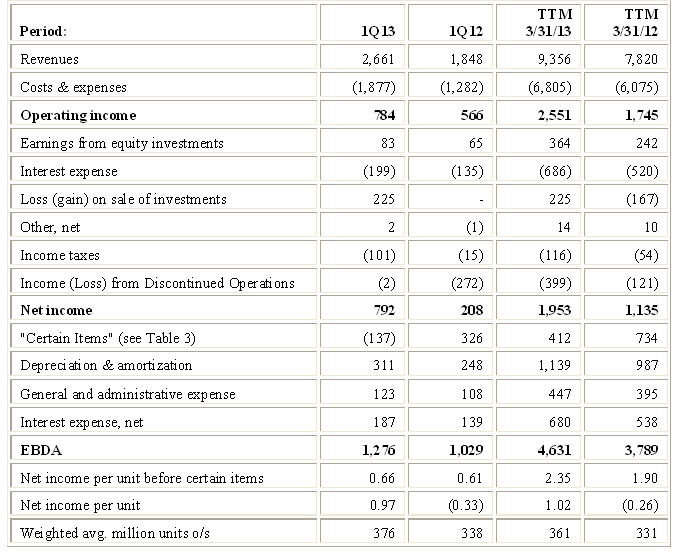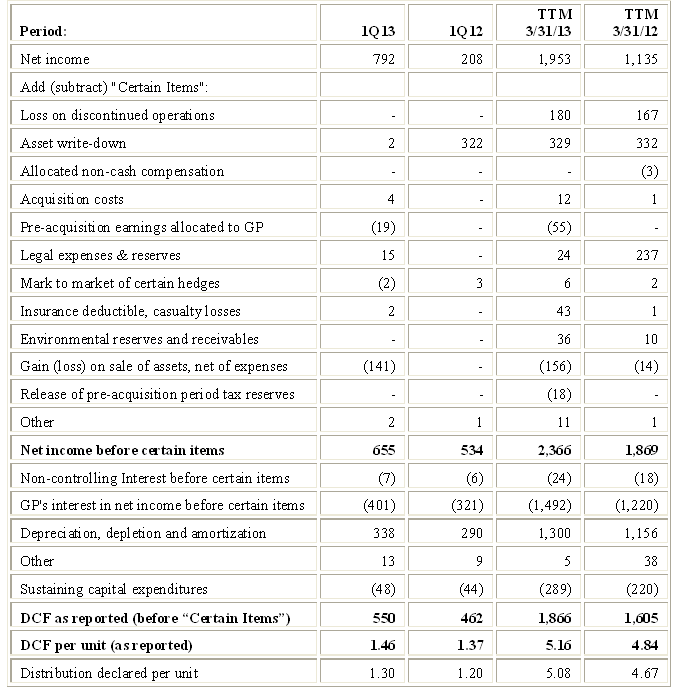On April 17, 2013, Kinder Morgan Energy, L.P. (KMP) reported its financial results for 1Q13. Given quarterly fluctuations, a review of trailing 12 months (“TTM”) revenues, expenses, net income and other items affecting Distributable Cash Flow (“DCF”) should be undertaken, in addition to reviewing the quarterly numbers. Therefore, Table 1 below adds TTM numbers to certain key items reported by KMP for 1Q13 and 1Q12:
“EBDA” denotes segment earnings before depreciation, depletion, amortization and amortization of excess cost of equity investments (“DD&A”), before “Certain Items”, before certain general and administrative (“G&A”) expenses, and before interest expense. These certain G&A expenses include employee benefits, legal, information technology and other costs that are not deemed controllable by operating management and thus are not included in the measure of performance for which each segment is accountable.
Management considers EBDA to be an important metric because it measures the ability of each segment to generate cash on an ongoing basis and it uses EBDA to make chief operating decisions about allocating resources to the segments and to assess the segments’ respective performance. Table 2 below adds TTM numbers to EBDA by segment as reported by KMP for 1Q13 and 1Q12: 
The improvements in EBDA shown in Table 2 were driven primarily by the Natural Gas Pipelines segment. This segment accounted for 88% of the increase in 1Q13 over 1Q12 and 69% of the increase in the TTM ended 3/31/13 over the prior year period. These increases were driven by the drop-downs of Tennessee Gas Pipeline (“TGP”) and El Paso Natural Gas (“EPNG”). Both occurred subsequent to the first quarter of 2012 and both are performing as expected.
The ~$5.1 billion acquisition of Copano Energy, L.L.C. (CPNO) is expected to close in May. It will add ~6,900 miles to the 62,000 miles of natural gas pipelines owned by KMP. The purchase price includes ~$1 billion of debt to be assumed and the balance will be paid for by an exchange of all CPNO units for ~45 million KMP units. The transaction is expected to add slightly to DCF per unit in 2013 and add ~$0.10 to DCF per unit in 2014.
Table 3 below adds TTM numbers to KMP’s April 18 press release which provides a reconciliation of net income to reported DCF for 1Q13 and 1Q12: 
Table 3 reflects KMP’s method of determining DCF. This method is detailed in an article titled Distributable Cash Flow (“DCF”) which also provides a comparison to definitions used by other master limited partnerships (“MLPs”). The method appears to me to be excessively complex; it also differs considerably from the method used by other MLPs I have covered and therefore makes comparisons more difficult.
Distributions declared grew by 8.8% per unit on a TTM basis (through 3/31/13) while DCF per unit (as reported) grew by only 6.6%. These two metrics were brought closer to being in balance with the 1Q13 distribution. It is up by only $0.01 from 4Q12, while DCF per unit in 1Q13 increased by $0.11 in the same period ($1.46 from $1.35 in 4Q12). In 2013 KMP projects reaching $5.4 billion of EBDA and retaining $30 million of excess cash flow after distributing $5.28 per unit to limited partners.
More light will be shed on the improvement in DCF cited by management (up $88 million in 1Q13 vs. 1Q12 and up $261 million in the TTM ended 3/31/13 vs. the prior year period) when KMP provides additional information as part of its 10-Q filing. An analysis of sustainable DCF can then be completed.
- English (UK)
- English (India)
- English (Canada)
- English (Australia)
- English (South Africa)
- English (Philippines)
- English (Nigeria)
- Deutsch
- Español (España)
- Español (México)
- Français
- Italiano
- Nederlands
- Português (Portugal)
- Polski
- Português (Brasil)
- Русский
- Türkçe
- العربية
- Ελληνικά
- Svenska
- Suomi
- עברית
- 日本語
- 한국어
- 简体中文
- 繁體中文
- Bahasa Indonesia
- Bahasa Melayu
- ไทย
- Tiếng Việt
- हिंदी
A Closer Look: Kinder Morgan Energy
Published 04/23/2013, 02:37 AM
Updated 07/09/2023, 06:31 AM
A Closer Look: Kinder Morgan Energy
3rd party Ad. Not an offer or recommendation by Investing.com. See disclosure here or
remove ads
.
Latest comments
Install Our App
Risk Disclosure: Trading in financial instruments and/or cryptocurrencies involves high risks including the risk of losing some, or all, of your investment amount, and may not be suitable for all investors. Prices of cryptocurrencies are extremely volatile and may be affected by external factors such as financial, regulatory or political events. Trading on margin increases the financial risks.
Before deciding to trade in financial instrument or cryptocurrencies you should be fully informed of the risks and costs associated with trading the financial markets, carefully consider your investment objectives, level of experience, and risk appetite, and seek professional advice where needed.
Fusion Media would like to remind you that the data contained in this website is not necessarily real-time nor accurate. The data and prices on the website are not necessarily provided by any market or exchange, but may be provided by market makers, and so prices may not be accurate and may differ from the actual price at any given market, meaning prices are indicative and not appropriate for trading purposes. Fusion Media and any provider of the data contained in this website will not accept liability for any loss or damage as a result of your trading, or your reliance on the information contained within this website.
It is prohibited to use, store, reproduce, display, modify, transmit or distribute the data contained in this website without the explicit prior written permission of Fusion Media and/or the data provider. All intellectual property rights are reserved by the providers and/or the exchange providing the data contained in this website.
Fusion Media may be compensated by the advertisers that appear on the website, based on your interaction with the advertisements or advertisers.
Before deciding to trade in financial instrument or cryptocurrencies you should be fully informed of the risks and costs associated with trading the financial markets, carefully consider your investment objectives, level of experience, and risk appetite, and seek professional advice where needed.
Fusion Media would like to remind you that the data contained in this website is not necessarily real-time nor accurate. The data and prices on the website are not necessarily provided by any market or exchange, but may be provided by market makers, and so prices may not be accurate and may differ from the actual price at any given market, meaning prices are indicative and not appropriate for trading purposes. Fusion Media and any provider of the data contained in this website will not accept liability for any loss or damage as a result of your trading, or your reliance on the information contained within this website.
It is prohibited to use, store, reproduce, display, modify, transmit or distribute the data contained in this website without the explicit prior written permission of Fusion Media and/or the data provider. All intellectual property rights are reserved by the providers and/or the exchange providing the data contained in this website.
Fusion Media may be compensated by the advertisers that appear on the website, based on your interaction with the advertisements or advertisers.
© 2007-2024 - Fusion Media Limited. All Rights Reserved.
